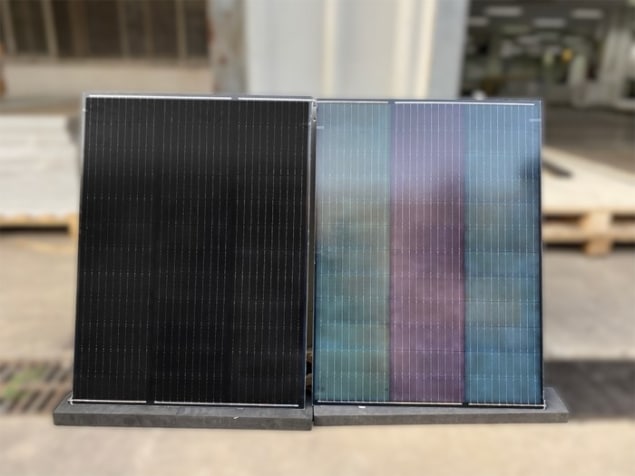Colourful solar panels could brighten your roof, global warming accelerates snapping shrimp
19 Aug 2022 Hamish Johnston
Rainbow panels: photonic glasses give solar panels colours while maintaining their ability to produce energy. (Courtesy: ACS Nano 2022, DOI: 10.1021/acsnano.2c05840)
Worldwide, solar panels are being installed on rooftops at an astonishing rate. But so far, high-efficiency panels only come in one colour, black, which might put off people who would like a more colourful roof.
Now, Tao Ma and Ruzhu Wang at Shanghai Jiao Tong University and colleagues in China have created solar panels that come in a number of different colours – rather than just the monotonous black of normal panels. They did this using structural colour, which involves placing a disordered film of tiny spheres over the panels. This reflects light over a narrow range of wavelengths, and the colour of the reflected light can be adjusted by changing the size of the spheres.
Structural colour was used because it allows most of the incoming light to pass into the active area of a solar panel. However, previous attempts to use the phenomenon were either too expensive to be practical – or resulted in iridescence, whereby the colour of the panel changes depending on the viewing angle.
Reduced efficiency
Of course, the cost of reflecting some of the light is a reduction in efficiency – with the team’s blue, green and purple panels achieving 21.5% efficiency, whereas an uncoated panel achieved 22.6%. On the upside, the researchers say that the coated panels are robust and that the coating process could be scaled up for commercial production. The panels are described in a paper in ACS Nano.
Here at Physics World we do like a story about shrimp, which are extraordinary creatures. For example, we have written about shrimp inspiring new and very tough materials and a new hyperspectral and polarimetric light sensor.
Now, Ashlee Lillis and Aran Mooney of Woods Hole Oceanographic Institution in the US have found that the loud popping sounds of snapping shrimp increase both in amplitude and frequency as warm temperature increases.
Sizzling bacon
The tiny crustaceans are found in temperate and tropical coastal marine environments around the world. The sound they produce is likened to sizzling bacon and can be so loud that it can interfere with sonar systems.
In a study done on the North Carolina coast, Lillis and Mooney found an increase of 1–2 dB in loudness, as well as a 15–60% increase in snapping frequency, for every Celsius degree rise in temperature. As a result, the researchers expect that local marine soundscapes will change significantly as the oceans warm because of climate change. This could affect creatures that rely on sound to communicate or navigate – including whales and dolphins, which some scientists believe use the snapping sound to orient themselves with coastlines. The duo is also concerned that physiological changes associated with louder and higher frequency snapping could harm the shrimp.
The study is described in Frontiers in Marine Science.

Hamish Johnston is an online editor of Physics World
from physicsworld.com 28/8/2022

Δεν υπάρχουν σχόλια:
Δημοσίευση σχολίου